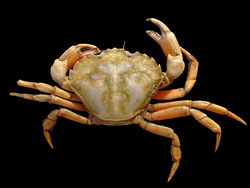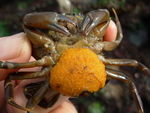European green crab
| European green crab |
|---|
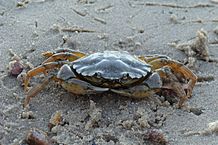
|
| Scientific Classification |
|
| Scientific Name |
|
Carcinus maenas[1] |
| A lab picture of Carcinus maenas |
The European green crab is a species of crab known by the scientific name Carcinus maenas. Even though it's called the "green" crab, it isn't always green, as it changes color during molting season. They are perhaps best known in the US as an invasive species
Body Design
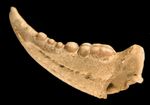
The European Green Crab has an exoskeleton, to defend predators by blending in with sand, shells, and rock.[2]They also shed their shell/skin in their growth process.[3] The average length of an adult crab is 6-10 centimeters wide. The color of the green crab’s shell is usually yellow, dark brown, and dark green. The claws have some black dots on the palm, and the legs are speckled with black. Other animals will know what it is, because of its distinct color. The undersides of the crab can be all different colors, ranging from green, to orange, to even red. The younger Green Crabs can also be different variations of colors like green, black, rust, and white.[4]
There are some things that you can tell right away about the Green Crab one characteristic is that it has five spines on the side of their eyes. Another characteristic is that most crabs have swimming paddles, but this crab doesn’t. [5]Most adult crabs grow from 36 inches to 48 inches in width, but not this one. The adult Green Crab’s average width is three to four inches across.[4]
Life Cycle
The European Green crab first made its way to the US in the mid 1800's via sailing ship to Cape Cod. [5]. The European green crab’s native waters are the Atlantic coast of Europe and Northern Africa, starting at Norway and the British Isles South of Mauritania. [5] The green crab lives in tidal marshes, sand flats, rocky shores, and can also be found on cobble beaches. [5] The green crab lives in a wide range of salinities with a range from 4-54 parts per thousand (ppt). [5] The green crab has a high tolerance for temperature changes living in a range from 0-33 degrees Celsius. [5] While in its native living area eats a large enough amount of mussels, dog whelks, and cockles to affect their population in Europe. [5]
The growth of the green crab in Oregon for example is much faster than in the North Sea, or Portugal. [6] When the crab loses its shell to get a new one it is consistent in size no matter the region it is located. [6] The one noted difference is that the green crabs in Oregon are molting more often than anywhere else. [6] One reason for the frequent molting is because of the longer growing season. [6] Some of their predators are birds such as the sea gull or scoter. [6]
The mating process of the green crab starts out with the male crab looking for for the female crab who has recently molted her previous shell. [7] The female crab carries her eggs in a pouch under her abdomen where the male crab fertilizes them. [7] The female crab can lay as many as one hundred thousand eggs at one time.[7] After fertilization the female crab goes to deeper water where the eggs can begin to develop into larvae, or the zoe's stage. After this happens they will rise to the surface waters for about two weeks.[7] Once they have reached their final stages of development the young crabs will travel to the coastal waters and will begin their own molting cycles.[7] It will take another three years before the young crabs are at a full adult stage and can reproduce themselves. [7]
Ecology
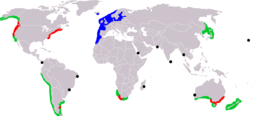
Carcinus maenas (European Green Crab) is native to the coasts of Europe and Africa, along the Atlantic, Mauritania, the British Isles, Norway[8], Morocco, the Netherlands, Portugal, and Spain.[9] It lives in mud, sand, rock substrates, marshes, and aquatic vegetation that is underwater.[8] It can live as deep in the water as six meters-- though there have been records of sixty meters set.[9]
C. maenas is considered an omnivore.[10] In the crab's indigenous range, it eats mostly snails, juvenile fish[9], mussels (Mytilus spp.), cockles (Cerastoderma edule), dogwhelks (Nucella lapillus)[11] and winkles(Littorina sp.). It also eats plants like cord grass(Spartina sp.) and algae. Generally, the smaller crabs have more arthropods and plant matter in their diet than the larger ones.
The crabs are eaten by a variety of animals, depending on location and size. Predators range from fish, otters, and birds(cormorants, gulls, eider ducks).[10]
If the European Green Crab species were to take a major hit, it would be able able to recover quite well due to the frequency of reproduction, the sheer amount of eggs that are produced by the females (up to 185,000), and the fact that adults move fast and have been known to travel as much as 15km in just six months.[10] The crabs typically mate annually from June to October in the North Sea.[11]
C. maenas is also known to carry multiple parasites-- for example, Sacculina carcini, which prevents the crab from molting or reproducing. Another is Profilicollis botulus, which infects the eider ducks that eat the crabs. Juvenile eider ducks tend to perish from P. botulus due to heavy infections.[10]
Invasive Species
Location and Method of Introduction
Environmental Impact The European Green Crab has had a large impact on the U.S. It consumes large quantities of shellfish like small oysters, crabs, and clams-- in fact, just one C. maenas can eat as many as 40 half-inch clams a day.[11]
Interestingly, some studies from Europe have shown that the feeding rate goes down with increasing bivalve size and decreasing crab size. This explains why a crab is able to eat near three-dozen mussels that are 45 mm and smaller in one day. However, if the crab is dealing with oysters larger than 45 mm (up to 60 mm), then it can only eat about three in the same amount of time. This also explains why the crabs eat such large quantities of young bivalves. It is more capable of opening the shell of animals that are smaller and weaker.[11]
Control Methods Established control methods for the east coast consists of using pyramid traps baited with fish that are set in water and attached to buoys, in much the same fashion as the blue crab is captured.[12] In Washington on the west coast there is an Exotic species group that was established in 1998. [12] They submitted recommendations for arriving boats and established volunteer programs with its citizens with other agencies and local crab fishermen.[12] The local fishermen and oyster growers were used to catch the crabs in similar traps as those used on the east coast.[12] They established a bounty program on the east coast to help control populations and mollify the effects on scallop fishing, but they have not been able to eliminate the species.[12] As globalization continues the spread of the green crab will continue to grow beyond its current locations.[12] One way they are considering to eradicate them is to introduce the green crabs nemesis the Sacculina carbine barnacle. The barnacle pierces the crabs exoskeleton and causes sterility.[12]
Video
The story of the European Green Crab....
References
- ↑ 1.0 1.1 Carcinus maenas Wikispecies. Web. Last modified November 4, 2015. Authors Unknown.
- ↑ Pleus, Allen. [1] "Washington Department of Fish & Wildlife". Web. October 30,2016 (access date)
- ↑ "Alaska Department of Fish and Game. Web. October 29, 2016 (access date)
- ↑ 4.0 4.1 Perry, Harriet. Carcinus maenas Linnaeus 1758 "USGS". Web. Revised September 13, 2011.
- ↑ 5.0 5.1 5.2 5.3 5.4 5.5 5.6 Pleus, Allen. Washington Department of Fish & Wildlife. Web.accessed October 30,2016
- ↑ 6.0 6.1 6.2 6.3 6.4 Yamada, Sylvia Behrens. Aquatic European Green Crab Species Overview. Web. accessed October 30, 2016
- ↑ 7.0 7.1 7.2 7.3 7.4 7.5 Tutt, Chris. Encyclopedia of Life. Web. accessed November 7, 2016
- ↑ 8.0 8.1 Perry, Harriet. Carcinus maenas Linnaeus 1758 "USGS". Web. Revised September 13, 2011.
- ↑ 9.0 9.1 9.2 Gollasch, Stephan. Carcinus maenas Invasive Species Specialist Group. Web. Published April 25, 2009
- ↑ 10.0 10.1 10.2 10.3 Neal, K.J. & Pizzolla, P.F. Common shore crab (Carcinus maenas) The Marine Life Information Network. Web. Revise August 5, 2008
- ↑ 11.0 11.1 11.2 11.3 Ricketts, E.F. Carcinus maenas (European Green crab) Washington Department of Fish & Wildlife Conservation. Web. Accessed October 30, 2016
- ↑ 12.0 12.1 12.2 12.3 12.4 12.5 12.6 Heertum, Richard. Introduced Species Summary Project. Web. accessed November 7, 2016.
